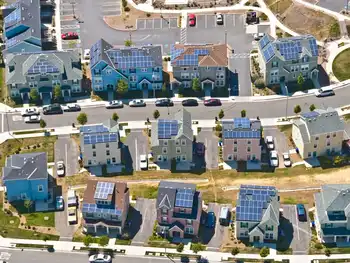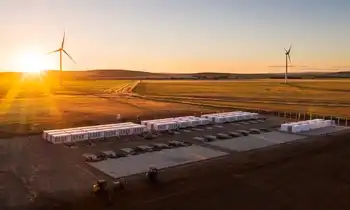Northwest leaders see bigger, greener power grid
By Idaho Statesman
NFPA 70e Training
Our customized live online or in‑person group training can be delivered to your staff at your location.

- Live Online
- 6 hours Instructor-led
- Group Training Available
Some 7,000 workers employed by the Works Progress Administration built Grand Coulee Dam - a mile wide and twice as tall as Niagara Falls - along with Bonneville Dam and a transmission grid that electrified the Northwest. The electricity from the dams still powers the region.
Now, as the current economic downturn deepens, there is talk of another major public works project for the Northwest - one that would spread green wind power throughout the region like it did hydropower in the 20th century. Some estimate it could create 50,000 jobs.
Plus, the region's lawmakers want money to expand the Bonneville Power Administration's transmission system.
The ideas could be a perfect fit with the incoming administration's support for green energy and green jobs. It also could emerge as a model for turning the nation's antiquated 200,000-mile transmission system into a clean energy superhighway.
"It's the sleeper issue," said Rep. Jay Inslee, the Washington Democrat who has emerged as one of the leaders on green energy issues and climate change in the House. "We need a grid for this century, not the last."
The Northwest is a microcosm of a problem bedeviling utilities nationwide. They want to develop renewable energy resources, mostly in remote areas, but face bottlenecks in delivering the power to population centers.
The BPA, one of a handful of not-for-profit federal utilities, markets about one-third of the electricity consumed in the region. It sells the power produced from 31 federally owned dams on the Columbia River and its tributaries. It also owns and operates 15,000 miles of high-voltage transmission lines.
About 20 percent of Idaho's electricity comes from the BPA, through rural electrical cooperatives and municipal utilities such as the one in Idaho Falls.
Washington and Oregon have adopted laws requiring utilities to start developing alternative sources of power. The renewable energy of choice in the region is wind.
Giant wind farms with state-of-the-art windmills have sprung up in the Columbia River Gorge and elsewhere east of the Cascade Mountains in Washington, Oregon and Idaho. So far, wind is generating about 2,000 megawatts of electricity in the region, enough to supply two cities the size of Seattle. Another 4,700 megawatts are expected to come on line in the next five or so years.
The problem is that the BPA and the region's private utilities, like Idaho Power, don't have enough capacity on existing transmission lines to carry the wind power from BPA's less-populated east side to the bustling Puget Sound and Oregon's Willamette Valley.
"Eight-five percent of our load is in the I-5 corridor, and there is no wind in that corridor," said Brian Silverstein, BPA's vice president for planning.
BPA wants to build about 600 miles of new transmission lines at a cost of about $1.5 billion. Several of the seven projects it has in mind are ready to go, with others still requiring environmental reviews. Idaho also has seven projects in various stages being pushed by its utilities.
Nationally, the Department of Energy predicts 20 percent of the United States could be powered by wind energy by 2030, but it would cost about $60 billion in new transmission lines and facilities to reach that target.
The problem is not just getting wind power to market, but also solar and other alternative energy resources. The nation's existing transmission system is woefully inadequate. In 2005, the American Society of Civil Engineers gave the grid a "D" rating, and a consulting firm, the Brattle Group of Cambridge, Mass., has estimated it would cost nearly $900 billion to modernize the system.
"In the Northwest and across the country, we need more transmission infrastructure to move electricity from remote areas into population centers like Seattle, and more coordinated regional grid operations," said Rob Gramlich, policy director at the American Wind Energy Association.
More transmission is important, said Sara Patton, executive director of the Northwest Energy Coalition, which advocates renewables and energy conservation. But BPA's public ownership also can help advance so-called "smart grid" applications that allow power marketers to automatically reduce power to individual homes and even appliances so they can manage load more efficiently, Patton said.
"The fact that it owns 75 percent of the transmission in the region gives us a huge opportunity," Patton said. "Where else in the country can we respond to the needs of this administration and the economy?"
All of this comes at a time when a credit crunch has made it harder and harder for utilities to borrow money.
Inslee, other Northwest lawmakers and public utilities are hoping the stimulus plan Congress wants to have on President-elect Barack Obama's desk the day of his inauguration could help solve the problem.
"It's one of those magic times when crisis is an opportunity," Inslee said.
Because it is a federal utility, BPA has what amounts to a line of credit with the U.S. Treasury, known officially as borrowing authority.
Washington state's two senators, Democrats Patty Murray and Maria Cantwell, have spoken to the Senate leadership about increasing the borrowing authority for BPA in the stimulus bill. The plan is to double the amount BPA can borrow, to more than $7 billion, to pay for the transmission upgrades, improvements at the dams and other projects.
Cantwell told the Senate Energy and Natural Resources Committee that an expanded BPA transmission system could create 50,000 direct and indirect jobs, including 4,700 construction jobs and 15,000 manufacturing jobs.
Only one of the five major transmission projects that either run across or near Idaho are "shovel ready," if stimulus money is available. But several of them fit into the larger regional renewable picture, Idaho office of Energy Resources Administrator Paul Kjellander said.
Idaho Republican Sen. Mike Crapo, who was just named co-chairman of the Senate Renewables and Energy Efficiency Caucus, said he has not heard of including expanded borrowing for BPA in a stimulus package, but he likes the goal.
"Expanding transmission lines, improving our use of renewable energy and improving fish passage are long-term bedrock goals of mine, and we continue to work as a united delegation on these fronts," Crapo said.











